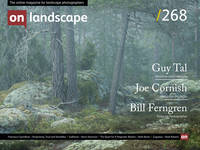Harris Steinman chooses one of his favourite images

Harris Steinman
Harris Steinman, originally a self-taught-photographer, has been photographing for over 40 years, since the age of 15.
Growing up in a quiet rural farming environment, he has immersed into the “noisy” world of science, people, and cities, resulting in a considerable influence on his visual interpretation of his surroundings. Later he began an informal mentorship and took various workshops, masterclasses, shifting his image-making into a more conscious and conceptually driven context.
I recently chanced on an image by Lars van den Brink, a photographer unknown to me. I was arrested in a most disquieting way. Besides finding the image incredibly beautiful and ethereal, I wondered, was it a photograph or a painting? If the former, was it constructed or heavily post-processed?
It is clearly moody and, to me, rather emotionally laden. The composition is exceptional and very traditional, almost allied to the “rule of thirds” (if one ascribes to that). But besides that, the mountains peer eerily and majestically through the clouds, and the small figures give an exceptional perspective on the sheer scale of the mountains, valley and building. Is the road from the building to the mountain naturally lit? And why did this image engage me so emotionally the way it did? Do the tiny figures make me feel insignificant? Does the moody, warm feel of the image evoke melancholy, awe, or other emotions?
Landscape photography has been my passion from an early age, following exposure to the photography of Ansel Adams. Adams’ images made a lasting impression on me, but subsequently, many other landscape photographers have contributed to my development as a landscape photographer.
As a young man trying to understand my discomfort with life, the influence of the works of Carl Jung was immeasurable and, specifically, prompted me to appreciate the power of the unconscious, particularly mine in an effort to understand why my landscapes are instinctively constructed the way they are. Why are they composed so differently, and why do they elicit particular emotions - and why can I not elucidate the reasons therefore?
Subsequently, the writings and philosophy of Guy Tal also had an incalculable impact on my development and appreciation as a photographer, in particular, his opinion that the final image should be an expression of the artist's vision rather than an accurate reflection of the camera.
That images, sounds and smells can invoke strong emotions is without a doubt. That the specific underlying association for the emotions may be confusing and ultimately non-determinable, does not negate the capacity of images to evoke in us multiple emotions.
It is, therefore, no surprise that although I am appreciative of a wide range of landscape images, those that affect me emotionally are particularly profound.

